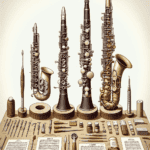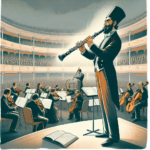The Rich History of the Clarinet
The clarinet has a rich and vibrant history that has evolved through centuries, shaped by numerous cultural influences and technological advancements. As we explore historical clarinet performance practices, it's important to recognize how each era contributed to the instrument's development. So, pick up your clarinet and join me on this fascinating journey!
The clarinet's roots can be traced back to the single-reed instruments used in the Middle Ages. It's amazing to think about, isn't it? The modern clarinet we know today started from such humble beginnings! It evolved from the chalumeau, a type of folk instrument. The dark and mellow sound of the chalumeau set the stage for the clarinet we're familiar with now.
Evolution of the Clarinet
| Era | Development |
|---|---|
| Middle Ages | Single-reed instruments, precursors to the clarinet |
| 18th Century | Bach and Mozart write distinct parts for clarinet |
| Romantic Era | Rise of virtuosic playing, expressive compositions |
| 20th Century | Jazz influence, new techniques like flutter tonguing |
The 18th Century: A New Era for the Clarinet
As we entered the 18th century, composers like Johann Sebastian Bach and later, Mozart, began to write more distinct parts for the clarinet. Bach's orchestral suites open a wonderful dialogue about clarinet's tonal qualities, while Mozart's Clarinet Concerto truly showcased the instrument's capacity for lush melodies and subtle expressiveness.
The Romantic Era: Expressiveness Takes Center Stage
The romantic era saw clarinetists really showing off their artistic abilities. Composers like Weber and Brahms wrote pieces that were incredibly expressive. The clarinet became a voice, conveying deep emotions. This period brought about the rise of virtuosic playing, where technical skill was just as important as musicality. It's no surprise that brands like Martin Freres emerged during this time, creating clarinets that made such extraordinary playing possible.
The 20th Century: Jazz and Beyond
As we moved into the 20th century, the clarinet continued to thrive, mixing styles from classical genres to popular music. The jazz movement, led by iconic artists like Benny Goodman, added new colors to the instrument's palette. Goodman's energetic performances and improvisational skills transformed the clarinet into the gold standard of jazz. He's often called the ‘King of Swing', and for good reason! His influence can be felt today by both jazz enthusiasts and classical purists alike.
Evolving Techniques
Let's talk about the varied techniques that have developed over time. From the use of flutter tonguing to multiphonics, clarinetists are always looking for ways to bring unique sounds into their performances. Historical practices show us that experimenting with breath control and sound production can lead to exciting creative expressions. Each technique adds a special touch that can make a performance truly unforgettable.
Early Clarinet Performers: Pioneers of Sound
It's also interesting to think about the role of early clarinet performers who didn't have the advantages of modern technology. Back then, clarinetists had to come up with their own ways of developing new techniques without the resources we have today. They relied heavily on ear training and personal experience, truly mastering their art from scratch. Can you imagine how exciting (and maybe a bit challenging) it must have been to explore these new territories?
The Importance of Maintenance
As you learn more, you might wonder about how maintenance affected historical performance practices. From experience, many of us have learned the importance of keeping our instruments in great condition. After all, you wouldn't want a sticky key to spoil your moment on stage! The brands we see today, like Martin Freres, stress that regular maintenance is a habit worth developing.
The Clarinet Community: Sharing Knowledge
And let's not forget about the sense of community among clarinetists. Performance practices have often been shared and passed down through workshops, masterclasses, and even casual get-togethers. There's something special about connecting with fellow clarinetists, sharing stories, techniques, and support. If you ever have the chance to join a clarinet choir or ensemble, go for it! The friendships you'll make are just as wonderful as the music.
Conclusion: Carrying the Legacy Forward
Understanding the historical clarinet performance practices enhances our approach to playing today. Whether you're just starting to learn your first notes, or you're an experienced player exploring advanced techniques, remember that every sound you create adds to this rich musical heritage. The clarinet has gone through quite a journey, and now it's your turn to carry this legacy forward. Pick up your clarinet, explore, and express yourself—your musical adventure is just beginning!
Table of Contents
- The Rich History of the Clarinet
- Evolution of the Clarinet
- The 18th Century: A New Era for the Clarinet
- The Romantic Era: Expressiveness Takes Center Stage
- The 20th Century: Jazz and Beyond
- Evolving Techniques
- Early Clarinet Performers: Pioneers of Sound
- The Importance of Maintenance
- The Clarinet Community: Sharing Knowledge
- Conclusion: Carrying the Legacy Forward







